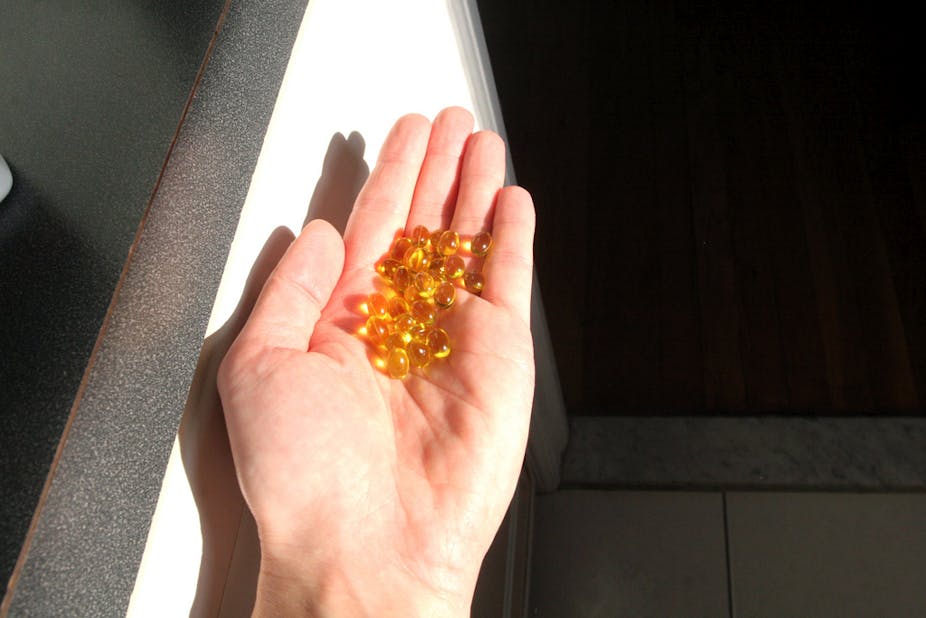Vitamin D is essential for healthy bones – low levels result in deformed limbs in children (rickets) and weakness and bone pain in adults. So there’s no question that we should all strive to maintain normal levels of this essential hormone.
But there are many uncertainties in vitamin D research. Enough uncertainties, in fact, to question whether advocating supplementation of everyday food with this vitamin may be premature.
The difficulty starts with defining the normal level of vitamin D that people should aim for. In their comprehensive review of research literature in 2010, a panel of experts at the US Institute for Medicine concluded that the evidence supported 50 nmol/L (nanomoles per litre) of 25-hydroxyvitamin D in blood as being sufficient for healthy bones.
Let’s talk about what these units mean first. Vitamin D is formed in the skin when it is exposed to ultraviolet radiation. This inactive form of vitamin D undergoes two biochemical reactions in the body – firstly in the liver, to make 25-hydroxyvitamin D, and then in the kidney to make the active form, 1,25-dihydroxyvitamin D.
This active form is present in blood in minute quantities and research has shown that the best measure of vitamin D status is the concentration of 25-hydroxyvitamin D. In Australia, we measure concentration in nanomoles per litre (nmol/L).
Despite the IoM report advocating 50 nmol/L, many researchers and clinicians favour a level of 75nmol/L or higher as optimal. And, to confuse the matter even further, there’s some evidence to support this level, particularly in relation to non-bone diseases in which vitamin D deficiency is thought to play a role, such as multiple sclerosis.
This raises a further difficulty. Our current assays or tests (there are several different types of methods, and several different manufacturers for each type) measure 25-hydroxyvitamin D poorly.
The most commonly used test in Australia tends to give lower values than the “gold standard” test – by a considerable amount. There’s now a program underway to improve measurement of vitamin D status to resolve this problem. But until this is implemented in Australia, it’s impossible to get a clear picture of whether vitamin D deficiency is a problem here.

If a test underestimates the true value of 25-hydroxyvitamin D in blood, for instance, and 75nmol/L is taken as the level that is optimal, then vitamin D deficiency will apparently be much more common than if a test overestimates and a level of 50nmol/L is “normal”. We cannot assess the problem until the issue of accurate measurement is resolved.
What’s more, the evidence for the benefits of vitamin D per se is still not really clear, even for bone health. Some studies suggest that it’s the combination of vitamin D and calcium that’s beneficial for fracture prevention, with vitamin D alone having little effect.
And amidst research showing that vitamin D is beneficial for a very broad range of diseases, there are a few disquieting reports of “U-shaped” effects on health – where increasing levels improve health to a point, but higher levels actually increase health risks. Researchers have seen this effect for prostate cancer, tuberculosis and for death from any cause (higher mortality). Such results are seen in a variety of research, including the very large US National Health and Nutrition Examination Survey (NHANES).
The possibility of a U-shaped association between vitamin D and health shouldn’t be surprising since it’s commonly seen with other factors: too cold and too hot are both bad for us; a little bit of stress and a lot of stress are bad for us; too little or too much of several vitamins causes health risks and, of course, too much sun or too little sun are both adverse.

There’s bound to be a range of vitamin D status within the normal population – with a few people having very low or very high levels, and the majority with levels in the middle of the range. What those actual levels are is hard to say accurately until we overcome the measurement issues. But supplementation of food shifts that whole distribution – so that the middle of the range becomes higher, and people in the high end of “normal” before are now too high. This will occur even though the dose used in fortification of any one food is low.
We are only starting to understand the risks associated with maintaining vitamin D status at those high levels for long periods of time – and food fortification will move a considerable chunk of our population into those levels.
In public health, the precautionary principle of “first do no harm” is often invoked. Australia is a sunny country and its people should be able to maintain normal vitamin D status (and not increase their skin cancer risk) with judicious sun exposure. Because of various biochemical reactions in the skin, it’s not possible to make too much vitamin D from sun exposure – but that is a very real possibility from ingesting vitamin D.
Before we adopt widespread fortification of foodstuffs, we need accurate and precise measurement of vitamin D status. Only then can we define what is “normal” according to those tests. That will allow us to measure the vitamin D status of Australia’s population to assess whether vitamin D deficiency is a problem or not. And then we can proceed in a way that we know will do no harm.

